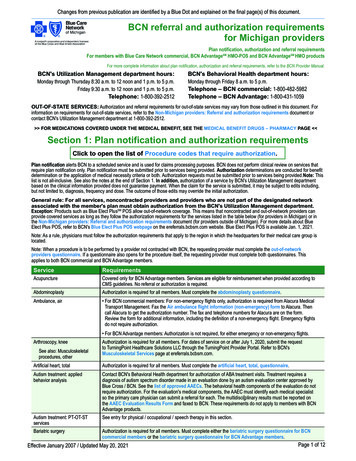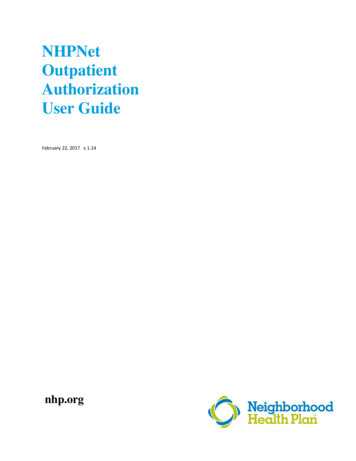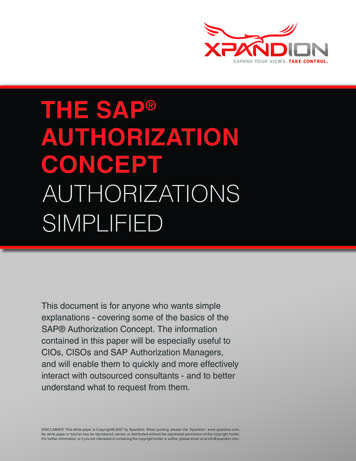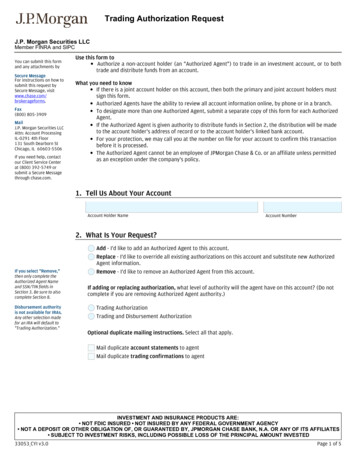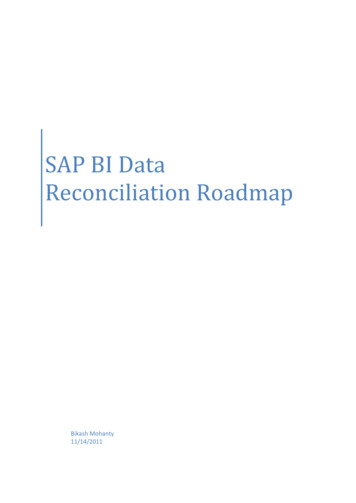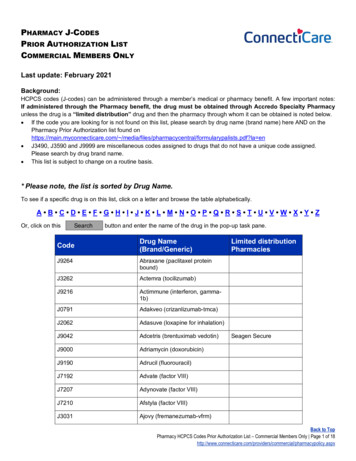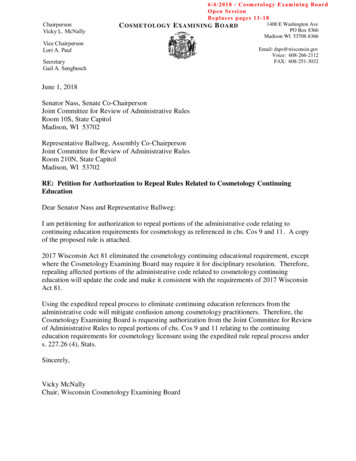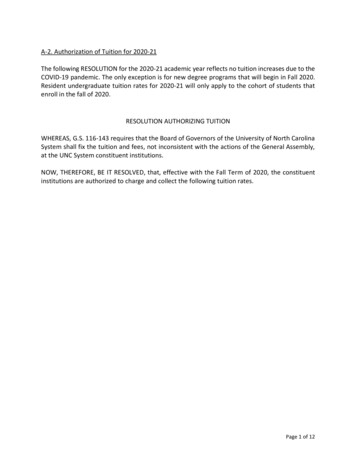
Transcription
Security and AuthorizationChapter 21Database Management Systems, 3ed, R. Ramakrishnan and J. Gehrke1Introduction to DB Security Secrecy: Users should not be able to seethings they are not supposed to. Integrity: Users should not be able to modifythings they are not supposed to. Availability: Users should be able to see andmodify things they are allowed to. E.g., A student can’t see other students’ grades.E.g., Only instructors can assign grades.Database Management Systems, 3ed, R. Ramakrishnan and J. Gehrke2Access ControlsA security policy specifies who is authorizedto do what. A security mechanism allows us to enforce achosen security policy. Two main mechanisms at the DBMS level: Discretionary access controlMandatory access controlDatabase Management Systems, 3ed, R. Ramakrishnan and J. Gehrke3
Discretionary Access ControlBased on the concept of access rights orprivileges for objects (tables and views), andmechanisms for giving users privileges (andrevoking privileges). Creator of a table or a view automatically getsall privileges on it. DMBS keeps track of who subsequently gains andloses privileges, and ensures that only requestsfrom users who have the necessary privileges (atthe time the request is issued) are allowed.Database Management Systems, 3ed, R. Ramakrishnan and J. Gehrke4GRANT CommandGRANT privileges ON object TO users [WITH GRANT OPTION] The following privileges can be specified: SELECT: Can read all columns (including those added latervia ALTER TABLE command).INSERT(col-name): Can insert tuples with non-null or non-default values in this column. INSERT means same right with respect to all columns.DELETE: Can delete tuples.REFERENCES (col-name): Can define foreign keys (in othertables) that refer to this column. If a user has a privilege with the GRANT OPTION, canpass privilege on to other users (with or withoutpassing on the GRANT OPTION).Only owner can execute CREATE, ALTER, and DROP.Database Management Systems, 3ed, R. Ramakrishnan and J. Gehrke5GRANT and REVOKE of Privileges GRANT INSERT, SELECT ON Sailors TO Horatio Horatio can query Sailors or insert tuples into it.GRANT DELETE ON Sailors TO Yuppy WITH GRANTOPTION Yuppy can delete tuples, and also authorize others to do so.GRANT UPDATE (rating) ON Sailors TO Dustin Dustin can update (only) the rating field of Sailors tuples.GRANT SELECT ON ActiveSailors TO Guppy, Yuppy This does NOT allow the ‘uppies to query Sailors directly!REVOKE: When a privilege is revoked from X, it isalso revoked from all users who got it solely from X.Database Management Systems, 3ed, R. Ramakrishnan and J. Gehrke6
GRANT/REVOKE on ViewsIf the creator of a view loses the SELECTprivilege on an underlying table, the view isdropped! If the creator of a view loses a privilege heldwith the grant option on an underlying table,(s)he loses the privilege on the view as well;so do users who were granted that privilegeon the view! Database Management Systems, 3ed, R. Ramakrishnan and J. Gehrke7Views and Security Views can be used to present necessaryinformation (or a summary), while hidingdetails in underlying relation(s).Given ActiveSailors, but not Sailors or Reserves, wecan find sailors who have a reservation, but not thebid’s of boats that have been reserved. Creator of view has a privilege on the view if(s)he has the privilege on all underlying tables. Together with GRANT/REVOKE commands,views are a very powerful access control tool. Database Management Systems, 3ed, R. Ramakrishnan and J. Gehrke8Role-Based AuthorizationIn SQL-92, privileges are actually assigned toauthorization ids, which can denote a singleuser or a group of users. In SQL:1999 (and in many current systems),privileges are assigned to roles. Roles can then be granted to users and to otherroles.Reflects how real organizations work.Illustrates how standards often catch up with “defacto” standards embodied in popular systems.Database Management Systems, 3ed, R. Ramakrishnan and J. Gehrke9
Security to the Level of a Field!Can create a view that only returns one fieldof one tuple. (How?) Then grant access to that view accordingly. Allows for arbitrary granularity of control,but: Clumsy to specify, though this can be hiddenunder a good UIPerformance is unacceptable if we need to definefield-granularity access frequently. (Too manyview creations and look-ups.)Database Management Systems, 3ed, R. Ramakrishnan and J. Gehrke10Internet-Oriented Security Key Issues: User authentication and trust. When DB must be accessed from a secure location, passwordbased schemes are usually adequate. For access over an external network, trust is hard toachieve. If someone with Sam’s credit card wants to buy from you, howcan you be sure it is not someone who stole his card? How can Sam be sure that the screen for entering his creditcard information is indeed yours, and not some rogue sitespoofing you (to steal such information)? How can he be surethat sensitive information is not “sniffed” while it is being sentover the network to you? Encryption is a technique used to address these issues.Database Management Systems, 3ed, R. Ramakrishnan and J. Gehrke11Encryption “Masks” data for secure transmission or storage Encrypt(data, encryption key) encrypted data Decrypt(encrypted data, decryption key) original data Without decryption key, the encrypted data is meaninglessgibberish Symmetric Encryption: Encryption key decryption key; all authorized users knowdecryption key (a weakness). DES, used since 1977, has 56-bit key; AES has 128-bit(optionally, 192-bit or 256-bit) key Public-Key Encryption: Each user has two keys: User’s public encryption key: Known to all Decryption key: Known only to this user Used in RSA scheme (Turing Award!)Database Management Systems, 3ed, R. Ramakrishnan and J. Gehrke12
RSA Public-Key Encryption Let the data be an integer IChoose a large ( I) integer L p * q p, q are large, say 1024-bit, distinct prime numbers Encryption: Choose a random number 1 e L that isrelatively prime to (p-1) * (q-1) Decryption key d: Chosen so that Encrypted data S Ie mod L d * e 1 mod ((p-1) * (q-1)) We can then show that I S d mod L It turns out that the roles of e and d can be reversed; sothey are simply called the public and private keysDatabase Management Systems, 3ed, R. Ramakrishnan and J. Gehrke13Certifying Servers: SSL, SET If Amazon distributes their public key, Sam’s browser will encrypt hisorder using it. But how can Sam (or his browser) know that the public key for Amazonis genuine? The SSL protocol covers this. So, only Amazon can decipher the order, since no one else has Amazon’sprivate key. Amazon contracts with, say, Verisign, to issue a certificate Verisign,Amazon, amazon.com, public-key This certificate is stored in encrypted form, encrypted with Verisign’s privatekey, known only to Verisign. Verisign’s public key is known to all browsers, which can therefore decryptthe certificate and obtain Amazon’s public key, and be confident that it isgenuine. The browser then generates a temporary session key, encodes it usingAmazon’s public key, and sends it to Amazon. All subsequent msgs between the browser and Amazon are encoded usingsymmetric encryption (e.g., DES), which is more efficient than public-keyencryption. What if Sam doesn’t trust Amazon with his credit card information? Secure Electronic Transaction protocol: 3-way communication betweenAmazon, Sam, and a trusted server, e.g., Visa.Database Management Systems, 3ed, R. Ramakrishnan and J. Gehrke14Authenticating Users Amazon can simply use password authentication, i.e., askSam to log into his Amazon account. Done after SSL is used to establish a session key, so that thetransmission of the password is secure! Amazon is still at risk if Sam’s card is stolen and his password ishacked. Business risk Digital Signatures: Sam encrypts the order using his private key, then encrypts theresult using Amazon’s public key. Amazon decrypts the msg with their private key, and thendecrypts the result using Sam’s public key, which yields theoriginal order! Exploits interchangeability of public/private keys forencryption/decryption Now, no one can forge Sam’s order, and Sam cannot claim thatsomeone else forged the order.Database Management Systems, 3ed, R. Ramakrishnan and J. Gehrke15
Mandatory Access Control Based on system-wide policies that cannot bechanged by individual users. Each DB object is assigned a security class.Each subject (user or user program) is assigned a clearancefor a security class.Rules based on security classes and clearances govern whocan read/write which objects.Most commercial systems do not support mandatoryaccess control. Versions of some DBMSs do supportit; used for specialized (e.g., military) applications.Database Management Systems, 3ed, R. Ramakrishnan and J. Gehrke16Why Mandatory Control? Discretionary control has some flaws, e.g., the Trojanhorse problem: Dick creates Horsie and gives INSERT privileges to Justin(who doesn’t know about this).Dick modifes the code of an application program used byJustin to additionally write some secret data to table Horsie.Now, Justin can see the secret info.The modification of the code is beyond the DBMSscontrol, but it can try and prevent the use of thedatabase as a channel for secret information.Database Management Systems, 3ed, R. Ramakrishnan and J. Gehrke17Bell-LaPadula ModelObjects (e.g., tables, views, tuples)Subjects (e.g., users, user programs) Security classes: Top secret (TS), secret (S), confidential (C),unclassified (U): TS S C UEach object and subject is assigned a class. Subject S can read object O only if class(S) class(O) (Simple Security Property)Subject S can write object O only if class(S) class(O) (*-Property)Database Management Systems, 3ed, R. Ramakrishnan and J. Gehrke18
Intuition Idea is to ensure that information can never flowfrom a higher to a lower security level.E.g., If Dick has security class C, Justin has class S,and the secret table has class S: Dick’s table, Horsie, has Dick’s clearance, C.Justin’s application has his clearance, S.So, the program cannot write into table Horsie.The mandatory access control rules are applied inaddition to any discretionary controls that are ineffect.Database Management Systems, 3ed, R. Ramakrishnan and J. Gehrke19Multilevel nSCUsers with S and TS clearance will see both rows;a user with C will only see the 2nd row; a userwith U will see no rows. If user with C tries to insert 101,Pasta,Blue,C : Allowing insertion violates key constraintDisallowing insertion tells user that there is anotherobject with key 101 that has a class C!Problem resolved by treating class field as part of key.Database Management Systems, 3ed, R. Ramakrishnan and J. Gehrke20Statistical DB SecurityStatistical DB: Contains information aboutindividuals, but allows only aggregate queries(e.g., average age, rather than Joe’s age). New problem: It may be possible to infer somesecret information! E.g., If I know Joe is the oldest sailor, I can ask “Howmany sailors are older than X?” for different valuesof X until I get the answer 1; this allows me to inferJoe’s age.Idea: Insist that each query must involve atleast N rows, for some N. Will this work? (No!)Database Management Systems, 3ed, R. Ramakrishnan and J. Gehrke21
Why Minimum N is Not EnoughBy asking “How many sailors older than X?”until the system rejects the query, can identifya set of N sailors, including Joe, that are olderthan X; let X 55 at this point. Next, ask “What is the sum of ages of sailorsolder than X?” Let result be S1. Next, ask “What is sum of ages of sailors otherthan Joe who are older than X, plus my age?”Let result be S2. S1-S2 is Joe’s age! Database Management Systems, 3ed, R. Ramakrishnan and J. Gehrke22Summary Three main security objectives: secrecy, integrity,availability.DB admin is responsible for overall security. Two main approaches to DBMS security: discretionaryand mandatory access control. Designs security policy, maintains an audit trail, or history ofusers’ accesses to DB.Discretionary control based on notion of privileges.Mandatory control based on notion of security classes.Statistical DBs try to protect individual data bysupporting only aggregate queries, but often, individualinformation can be inferred.Database Management Systems, 3ed, R. Ramakrishnan and J. Gehrke23
Database Management Systems, 3ed, R. Ramakrishnan and J. Gehrke 3 Access Controls A security policy specifies who is authorized to do what. A security mechanism allows us to enforce a chosen security policy. Two main mechanisms at the DBMS level:
